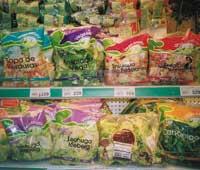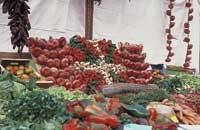Fresh fruits and vegetables… preserved?

In a time, however, lasting a long time was much more difficult. However, the human being had from the beginning the need to conserve food, since he had foreseen that he could then have scarcity and by then he had to keep something. To avoid deterioration during storage, different methods were used: salting, sugar, ice, sun-drying, cooking, smoked or transformation by action of microorganisms or fungi. That is, depending on the place and climate and taking into account the characteristics of each food, effective methods of conservation were achieved in different times and places.
Fruit and vegetables, the most perishable
Among the easiest to lose foods are fruits and vegetables. In fact, once collected, the metabolic processes of the plants do not stop. Although photosynthesis is almost completely inactive, cellular respiration continues. Consequently, carbohydrates, energy reserves of fruits and vegetables, are mainly transformed into carbon dioxide, water and energy.
They capture the oxygen necessary for the surrounding air reaction. The water produced becomes part of the cellular water and the carbon dioxide is released with heat. When there is not enough oxygen for breathing, there are by-products that give bad flavor like alcohols, aldehydes and ketones.

This aging process involves a decrease in the quality of the product that ultimately does not serve for consumption. In addition, as time progresses, fruit and vegetables weaken and are more vulnerable to aggression of microorganisms, fungi and yeasts. And in most cases they are the ones that make the product not suitable for consumption and not the chemicals produced by breathing.
Long before the damage is such, the buyer suffers changes that are easily recognizable and affect quality. The fruits and vegetables release water and are soon wrinkled (3-5% water loss causes deterioration of the structure). On the other hand, excess water accelerates putrefaction.
On the other hand, most of the fruits and vegetables are very fragile and the blows, cuts and other physical aggressions have a great influence on the mechanisms of deterioration that accelerate these processes.
Therefore, many forms of conservation of these foods have been invented. If it is for a short time, just keep it cold, but to last a lot chemical or physical treatments are used. The best known chemicals are sugar, salting, acidification with acids such as vinegar, fermentation and the addition of additives that prevent the growth of microorganisms.

Physical treatments are high temperatures, low temperatures and radiations. However, in most cases, several methods are used at a time, such as dehydration and freezing. In addition, the container must be appropriate to protect food from attack of microorganisms.
However, conservation methods modify the characteristics of food. Sometimes it's about getting it to get different products from the same raw material. However, if you want products not only to stay longer, but to retain their own characteristics, you need to use other methods.
In addition, consumers are increasingly worried about their diet and want to ensure that the fruits and vegetables they drink keep all their vitamins. They also renounce chemical additives. However, it seems a contradiction, but the way of life or comfort make many unwilling to buy fresh products on a daily basis.
For this reason, foods preserved in the modified atmosphere are increasingly known. It seems that they are very fresh, of the day. But if you discover the expiration date that appears in the portfolio, the buyer may have a surprise. These vegetables so cut in order last more than two weeks without wilting, changing color or deteriorating!
Method of conservation “soft”
The conservation in the modified atmosphere consists of replacing the air of the container with another mixture of gases. The aim of the new gas mixture is to reduce the breathing speed of fruit and vegetables. For this purpose the amount of oxygen is reduced on the one hand and on the other the addition of carbon dioxide. In addition, carbon dioxide changes the direction of the aerobic breathing mechanism. The same is achieved by adding water and avoiding the loss of water, thus contributing to preserving the original quality.

By preventing aerobic respiration, the growth of microorganisms and aerobic enzymatic reactions are stopped. However, the total elimination of oxygen is not convenient since the activity of the metabolism can have harmful effects and, for example, substances with a peculiar flavor appear. Therefore, if you want to achieve an adequate duration and quality of food, it is essential to carefully control the proportions of gases of the mixture.
When deciding the composition of the modified atmosphere, factors such as components and characteristics of the food, initial quantity of microorganisms, storage temperature and material of the containers should be taken into account. Although it seems that most fruits and vegetables can have a similar behavior, it is not. Therefore, it is necessary to carry out a detailed study of the characteristics of each food in order to choose the most suitable packaging atmosphere.
Traditional containers, that is, glass and metallic containers, are not suitable for conservation in the modified atmosphere. These materials are a total barrier for gases that completely impede the state changes of the interior atmosphere. Some plastic materials, on the contrary, are permeable and allow to control the atmosphere of the container. In this way, a balanced flow of gases is produced through these plastics: the same amount of oxygen consumed by fruit and vegetables passes into the container and at the same time comes the carbon dioxide released. Being a process that changes over time, in addition to the initial situation, we must take into account the global evolution.
Currently mathematical and computer models are used to select the most adequate amount of gas. When calculating, we take into account the nature of the products, the number of components, the temperature and humidity, and the algorithm directly provides the alternative result.

In the modified atmosphere, in addition to fruit and vegetables, other foods such as fresh pasta or chips are preserved. The materials most used for this purpose are polyolefin covers, often with microcinillas, as well as polystyrene or propylene trays covered by a retractable film. When more waterproofness and control are needed, multi-layer materials with components adapted to the needs of the products are used.
The last word has the buyer
However, in addition to the characteristics of the product and packaging, another agent is also involved in the choice of the material: the tastes of the buyer. In addition to being appropriate, the material must be attractive, otherwise the buyer rejects it and chooses another, even if the first is more effective in maintaining the product. And it is not the only contradiction that consumers manifest. According to a study conducted in Uruguay, fresh pasta, which normally lasts two days, was packaged in modified atmosphere and marketed with a expiration date of 20 days later. But the buyers showed their distrust by considering that the paste contained chemical additives. Finally, in order to sell it, the expiration date was limited to 10 days, although they could last the same. The response in favor was immediate.





